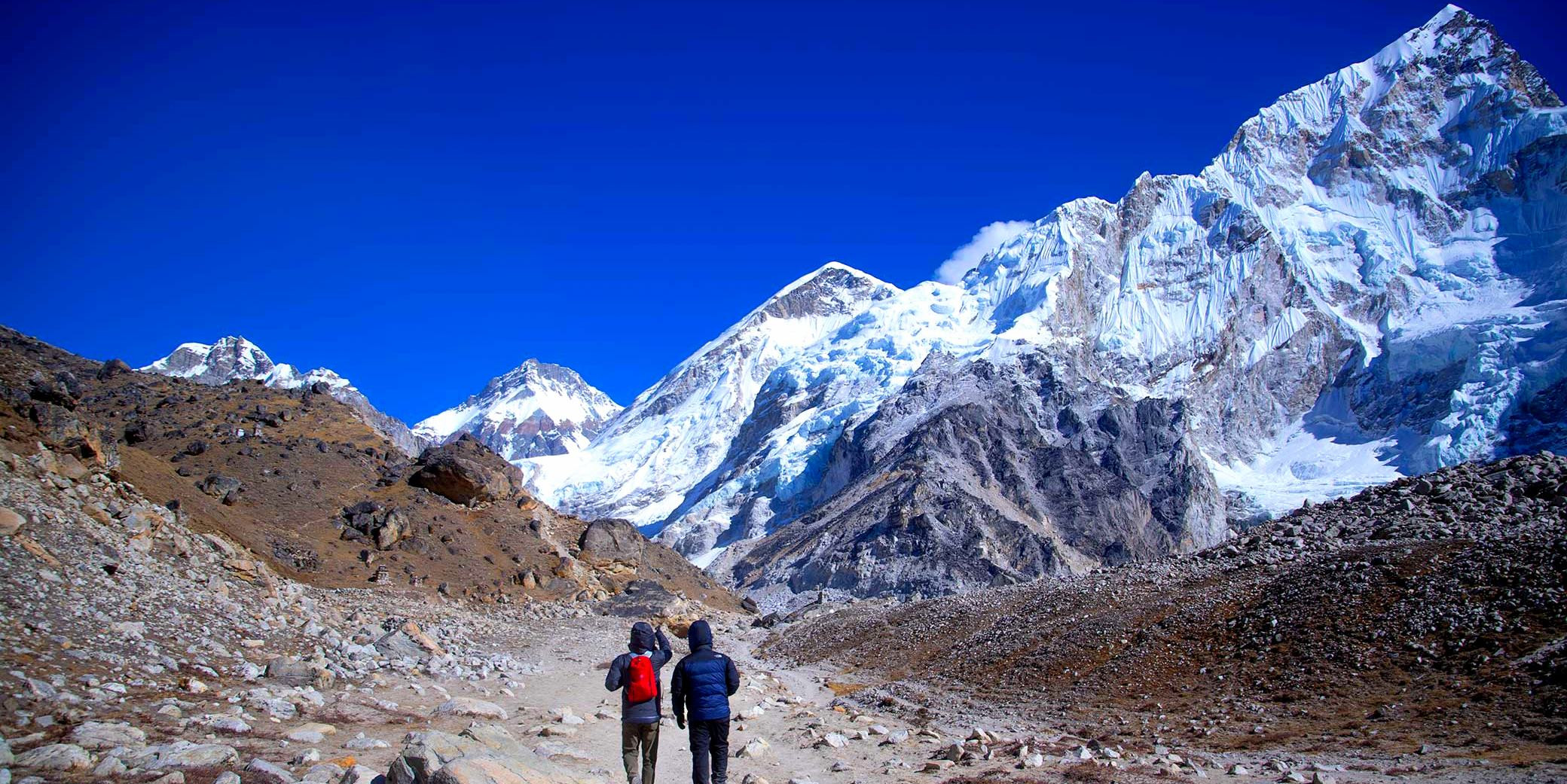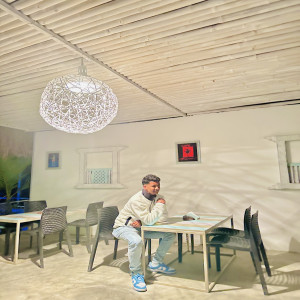Everest Base Camp
The Everest Base Camp (EBC) Trek is one of the most iconic and exhilarating trekking adventures in the world, attracting adventurers who want to soak in the majestic presence of the highest peak on Earth—Mount Everest (Sagarmatha in Nepali). This trek not only provides a breathtaking view of Everest but also offers an immersive cultural experience as you walk through the heartland of the Sherpa community. Here's a detailed look at what the trek involves:
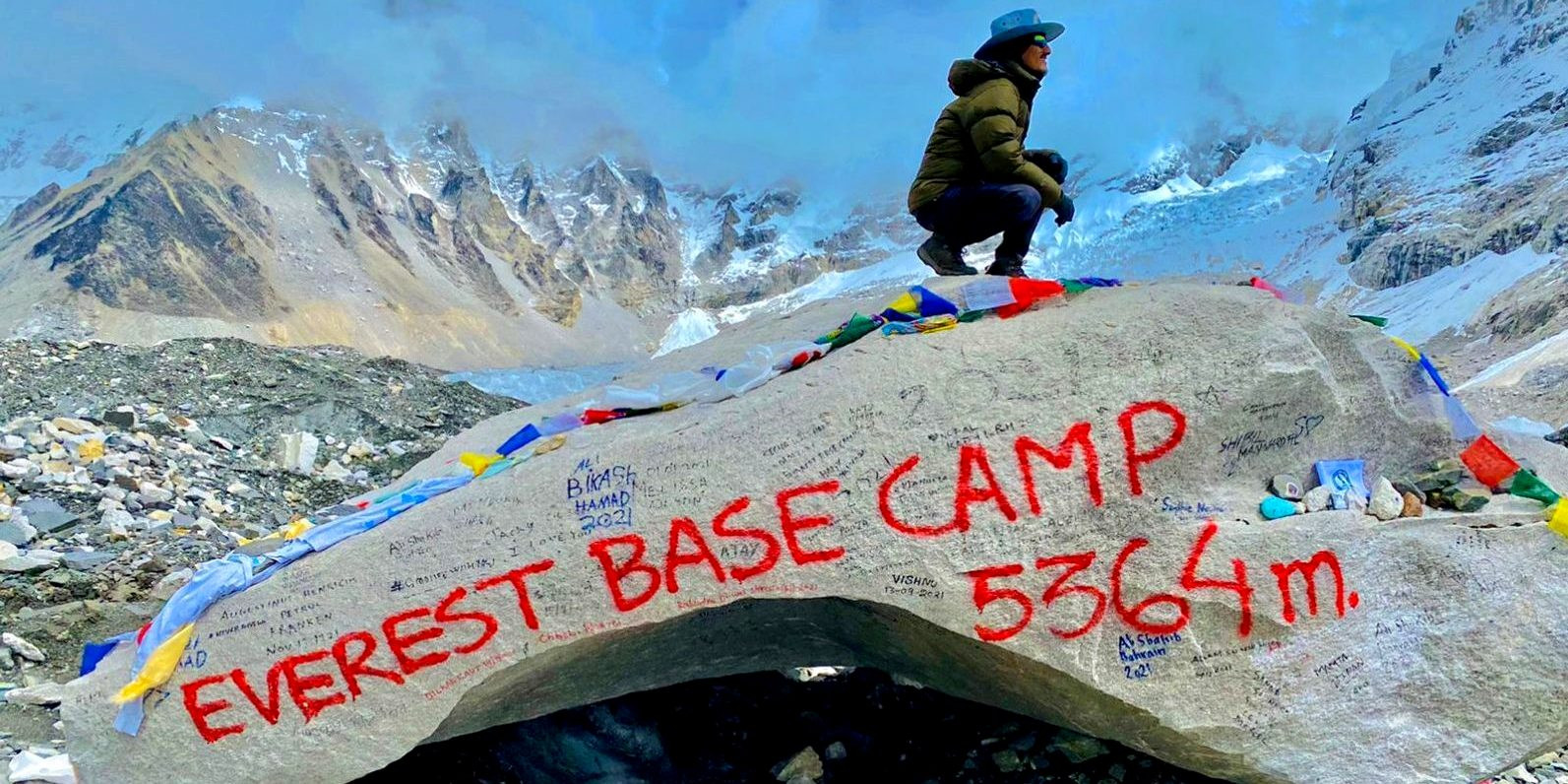
Route Overview: The journey typically starts with a flight from Kathmandu to Lukla, a small town with one of the most spectacular airstrips in the world. From Lukla, trekkers pass through Phakding and enter the Sagarmatha National Park, continuing through Namche Bazaar, the bustling Sherpa capital, which is a crucial acclimatization stop. Further along the trail, trekkers pass through villages like Tengboche, Dingboche, Lobuche, and Gorakshep before finally reaching Everest Base Camp.
Key Highlights
-
Kala Patthar: Although Everest Base Camp itself offers stunning views, the ascent to Kala Patthar (about 5,545 meters) is a common side trip that provides the most accessible point to view Mt. Everest from base to peak, along with spectacular panoramic views of the surrounding mountains.
-
Sherpa Culture: The trek provides an excellent insight into Sherpa culture and includes visits to monasteries and museums along the way.
-
Flora and Fauna: The trek traverses through varied ecosystems—from lush forests to stark glacial plains—within the Sagarmatha National Park, a UNESCO World Heritage Site.
Difficulty: The EBC Trek is considered moderate to challenging, primarily due to its high altitude. It typically takes about 12 to 14 days to complete, covering a distance of approximately 130 kilometers round trip. Altitude sickness is a risk due to the high elevation, so proper acclimatization days are built into the itinerary.
Preparation and Tips
-
Physical Fitness: The trek requires a good level of fitness, as trekkers need to handle several hours of walking per day on varied terrain.
-
Gear: Proper gear is essential, including sturdy trekking boots, thermal clothing, a down jacket, and a quality sleeping bag suitable for high-altitude conditions.
-
Insurance: It’s advisable to have travel insurance that covers high-altitude trekking up to 6,000 meters.
-
Guides and Porters: Hiring a knowledgeable guide and porters through a reputable company can enhance the trekking experience by providing insight into the local area and reducing the physical strain of carrying gear.
The Everest Base Camp Trek is more than just a hike; it's a journey into the heart of the Himalayas. It tests one's endurance and offers an unforgettable adventure with awe-inspiring landscapes and rich cultural encounters. For many, it’s a once-in-a-lifetime experience that leaves lasting impressions and a deep respect for the natural world.
Annapurna Circuit
The Annapurna Circuit Trek is widely renowned as one of the most spectacular and varied treks in the world. Circling the Annapurna massif and passing through a diverse array of landscapes and cultures, this trek offers an exceptionally enriching experience that showcases the beauty and diversity of the Nepalese Himalayas.
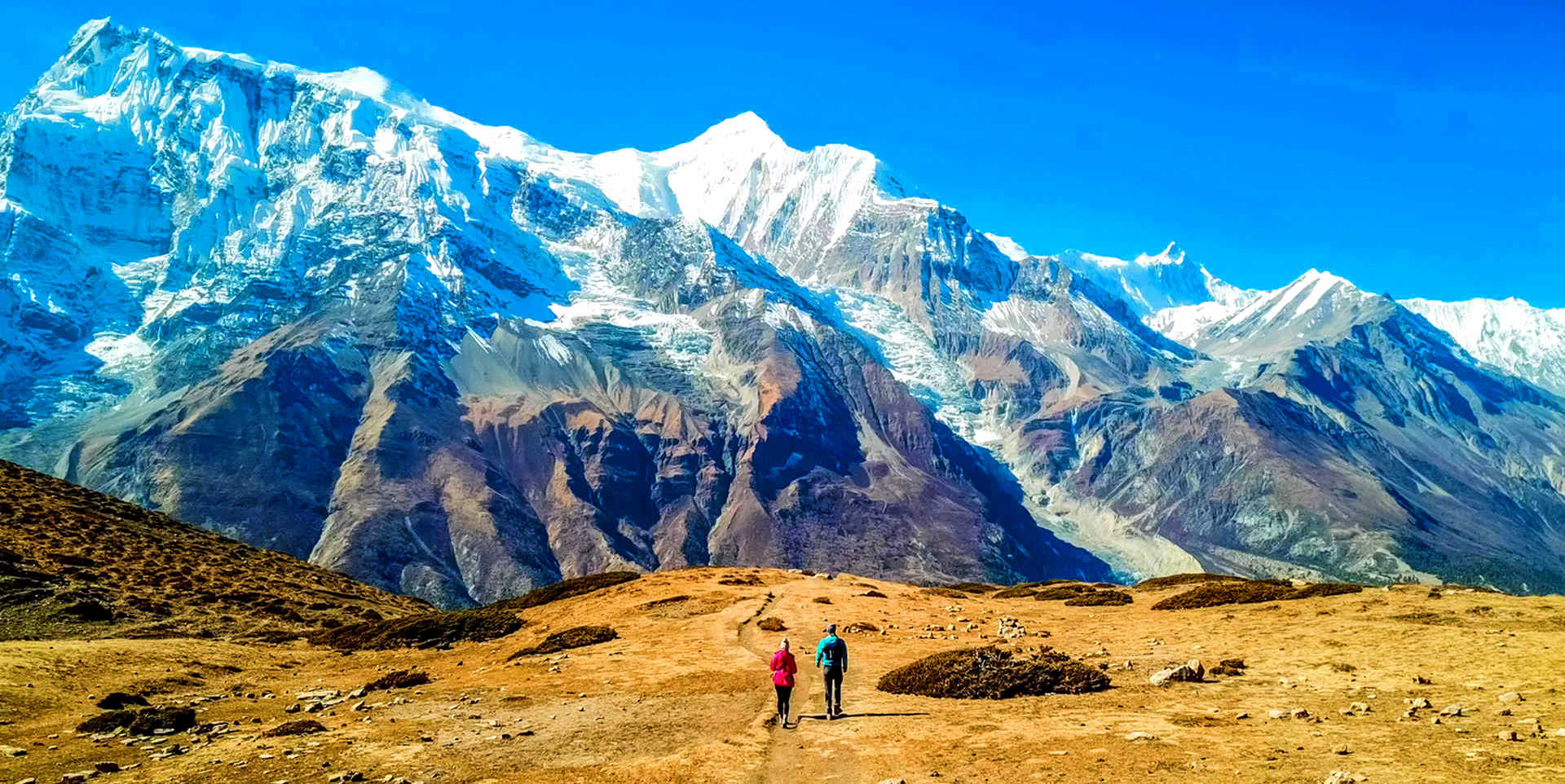
Route Overview: The trek traditionally starts in Besisahar or Bhulbhule in the Marsyangdi River valley and concludes in the Kali Gandaki Gorge, the world's deepest river gorge. The route leads you through lush subtropical forests, paddy fields, and the arid, high-altitude environment above the tree line. As the trail ascends, trekkers cross the Thorong La Pass, a high mountain pass at an elevation of 5,416 meters, which presents a challenging yet rewarding obstacle.
Key Highlights
-
Thorong La Pass: Crossing this high pass is a significant achievement and offers spectacular views of the Annapurna range and the Mustang region.
-
Muktinath: This sacred site for both Hindus and Buddhists marks the end of the high-altitude part of the trek and provides a fascinating cultural and spiritual experience.
-
Manang and Mustang Districts: These areas provide a glimpse into the Tibetan-style cultures of Nepal’s high-altitude regions.
-
Poon Hill: While not strictly part of the classic circuit, many trekkers choose to include a side trip to Poon Hill for sunrise views over the entire Annapurna Range.
Difficulty: The Annapurna Circuit Trek is considered moderate to challenging, mainly due to the length of the trek and the high altitude, especially while crossing Thorong La Pass. The trek usually takes about 12 to 21 days, depending on the exact route and pace of hiking.
Preparation and Tips
-
Acclimatization: Proper acclimatization is crucial, especially before crossing Thorong La Pass, to prevent altitude sickness.
-
Gear: Essential gear includes layers for varying temperatures, waterproof clothing, a good sleeping bag, and hiking boots that have been broken in.
-
Guide or Porter: While the trail is well-marked, hiring a guide or porter can enhance the trekking experience by providing local knowledge and logistical support.
-
Permits: Trekkers need both the Annapurna Conservation Area Permit (ACAP) and the Trekkers' Information Management System (TIMS) card.
The Annapurna Circuit offers a breathtaking trekking experience with its stunning natural beauty and rich cultural tapestry. Whether you are an experienced trekker or relatively new to high-altitude hiking, this trek provides a rewarding journey through one of the most beautiful and diverse landscapes on the planet. It’s a journey that not only challenges the body but also enriches the spirit, offering a profound connection to the natural and cultural world of the Nepalese Himalayas.
Langtang Valley
The Langtang Valley Trek is a serene and spectacular journey into one of the closest trekking regions near Kathmandu, yet it is often overshadowed by more famous treks like Everest Base Camp and Annapurna Circuit. Despite its proximity to the capital, the Langtang Valley offers a deeply immersive Himalayan experience with fewer crowds, making it an excellent choice for those looking for a more tranquil trek.
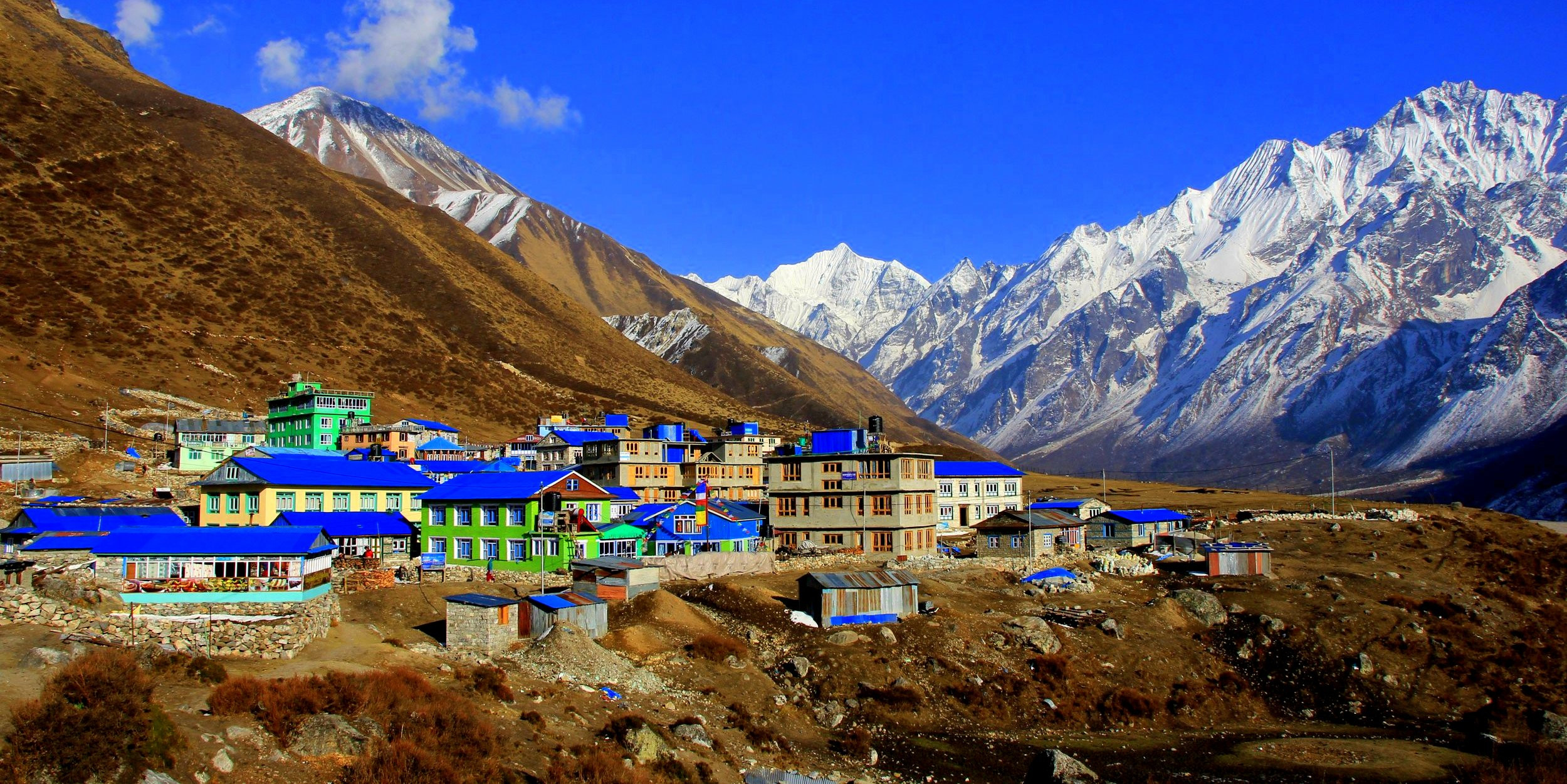
Route Overview: The trek typically starts from Syabrubesi, a small town a few hours' drive from Kathmandu. From there, trekkers ascend to the Langtang Valley, nestled between the main Himalayan range to the north, bordering Tibet, and a slightly lower range to the south. The trek passes through varied landscapes, including lush forests, rugged rocks, and alpine pastures. The route offers dramatic views of Langtang Lirung and Langtang Ri and eventually leads to the high alpine meadows and yak pastures around Kyangjin Gompa (a Buddhist monastery), where trekkers often spend a day to acclimatize and explore further.
Key Highlights
-
Kyangjin Gompa: Located at 3,870 meters, this is the spiritual and literal high point of the trek, offering opportunities to explore ancient monastic practices and enjoy panoramic mountain views.
-
Langtang Lirung and Surrounding Peaks: The valley provides up-close views of Langtang Lirung (7,234 meters) and other Himalayan peaks.
-
Local Culture: The region is home to the Tamang people, whose culture is similar to Tibetan Buddhism, providing a rich cultural experience along with the natural beauty.
-
Wildlife: The area is part of Langtang National Park, which is home to diverse wildlife, including the endangered red panda.
Difficulty: The Langtang Valley Trek is considered moderate. It typically takes about 7 to 12 days to complete, depending on side trips and the chosen pace. The maximum elevation reached is around 5,000 meters if trekkers opt to hike up to Tserko Ri for exceptional views.
Preparation and Tips
-
Acclimatization: Adequate time for acclimatization is necessary, especially if ascending to higher vantage points like Tserko Ri.
-
Gear: As with most Himalayan treks, layered clothing, sturdy trekking boots, and a comfortable pack are essential.
-
Permits: A TIMS card and a Langtang National Park permit are required for this trek.
-
Travel Insurance: Always recommended for treks in Nepal, covering high-altitude trekking.
The Langtang Valley Trek is a beautiful journey not just through the Himalayas but also through the vibrant culture of the Tamang people. It offers a quieter, albeit no less stunning, alternative to Nepal’s more crowded trekking routes. This trek provides not only natural wonders but also a chance to witness and engage with traditional Himalayan lifestyles, making it a meaningful and memorable adventure.
Manaslu Circuit
The Manaslu Circuit Trek is a remarkable journey around the world's eighth highest mountain, Mt. Manaslu, standing at 8,163 meters. This trek is often hailed as one of the best-kept secrets of Nepal, offering a less trodden path that retains a sense of remote adventure, unspoiled by the effects of mass tourism found in more popular trekking routes like Everest Base Camp and Annapurna Circuit.
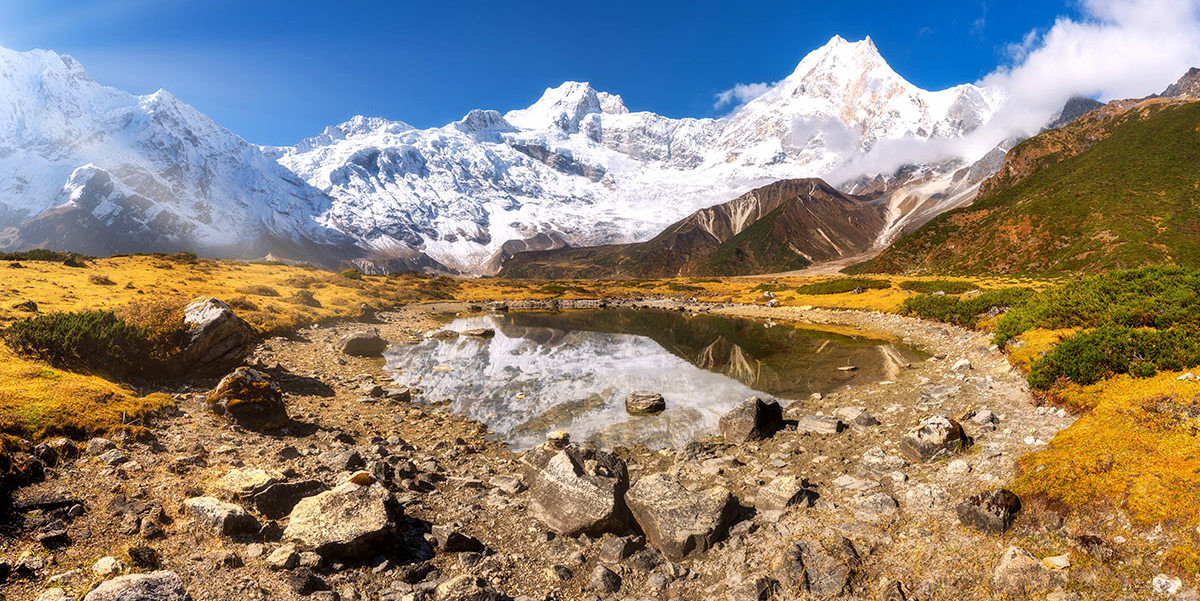
Route Overview: The trek begins in Arughat or Soti Khola, several hours' drive from Kathmandu, and follows the Budhi Gandaki River through lush, lowland forests and traditional farming villages. As you ascend, the valley narrows and the terrain becomes more rugged, leading into alpine forests and eventually to the stark, high-altitude landscapes above the tree line. The route passes through Tibetan-influenced villages and ancient Buddhist monasteries, particularly as it circles closer to Manaslu itself. The highlight of the trek is crossing the challenging Larkya La Pass at 5,106 meters, which offers dramatic views of Manaslu, Cheo Himal, Himlung Himal, and the surrounding peaks.
Key Highlights
-
Larkya La Pass: The high point of the trek, both literally and figuratively, provides breathtaking panoramic views of the Himalayas.
-
Cultural Experience: The trek goes through Tibetan-style villages where you can experience a culture that has remained intact due to the area's relative isolation.
-
Biodiversity: The Manaslu region is noted for its rich biodiversity, and you're likely to encounter a variety of flora and fauna unique to the area.
-
Tsum Valley: An optional side trip can take you to the sacred Tsum Valley, known for its pristine landscapes and ancient monastic traditions.
Difficulty: The Manaslu Circuit Trek is considered challenging due to its length, altitude, and the remote nature of the area. It typically takes about 14 to 20 days to complete, depending on side treks and weather conditions.
Preparation and Tips
-
Permits: Special restricted area permits are required for the Manaslu Circuit in addition to the Annapurna Conservation Area Permit (ACAP) and the Manaslu Conservation Area Permit (MCAP).
-
Guide Requirement: Due to the remote and challenging nature of this trek, a licensed guide is mandatory, enhancing safety and providing valuable insights into the local culture and environment.
-
Gear and Preparation: Adequate gear for cold and possibly harsh weather conditions is essential, along with a good level of physical fitness.
-
Acclimatization: Proper acclimatization days are crucial, especially before attempting the pass, to minimize the risk of altitude sickness.
The Manaslu Circuit Trek offers an authentic adventure for those looking to explore one of the more secluded corners of the Himalayas. Its challenging trails, stunning natural beauty, and rich cultural encounters make it a highly rewarding experience for those willing to venture off the beaten path. This trek not only tests your physical limits but also offers a profound connection to the natural world and the ancient heritage of the region.
Ghorepani Poon Hill
The Ghorepani Poon Hill Trek, also commonly known as the Poon Hill Trek, is one of the most accessible and popular treks in the Annapurna region of Nepal. Renowned for its stunning panoramic views of the Annapurna and Dhaulagiri mountain ranges, this trek is particularly famous for its spectacular sunrise views from Poon Hill. It is an excellent choice for those who want a relatively short and easy trek that still offers the breathtaking scenery typical of the Nepalese Himalayas.
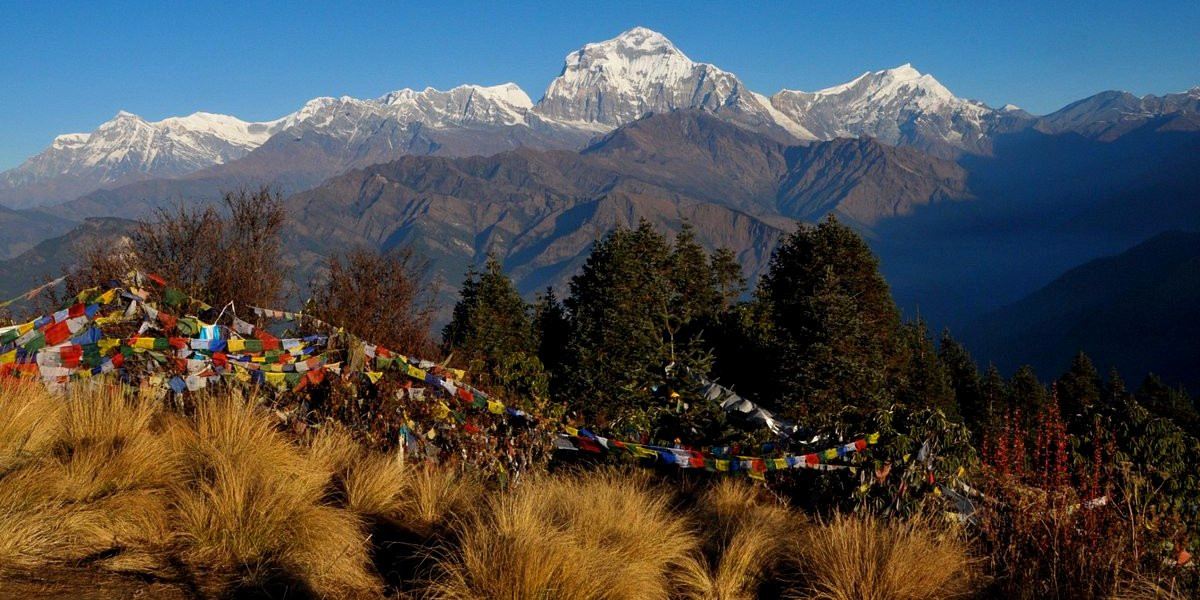
Route Overview: The trek usually begins in Nayapul, a short drive from Pokhara, and follows a loop through Ulleri, Ghorepani, Poon Hill, Tadapani, and Ghandruk, before returning to Nayapul. The route is well-trodden and comfortable, with many steps and well-established trails. The major highlight of the trek is the early morning ascent to Poon Hill (3,210 meters) to catch the sunrise over the Himalayas—a truly unforgettable experience.
Key Highlights
-
Sunrise at Poon Hill: Watching the sunrise over the snow-capped peaks of Annapurna South, Annapurna I, Dhaulagiri, and Machapuchare (Fishtail Mountain) is the defining feature of this trek.
-
Rhododendron Forests: If trekking in the spring, you'll walk through forests bursting with colorful rhododendrons and other wildflowers.
-
Cultural Experience: The trek passes through various villages where you can experience the warm hospitality and rich culture of the Gurung and Magar communities.
-
Accessibility: This trek is known for being family-friendly and is suitable for trekkers of all ages and fitness levels.
Difficulty: The Ghorepani Poon Hill Trek is considered easy to moderate, making it suitable for beginners and those not accustomed to high-altitude trekking. The trek can be completed in 4 to 5 days, with daily walking times of approximately 4-6 hours.
Preparation and Tips
-
Gear: Trekking boots, warm clothing, and rain gear are essential. The trek does not reach extreme altitudes, so standard hiking equipment is adequate.
-
Permits: A TIMS card (Trekkers' Information Management System) and an Annapurna Conservation Area Permit (ACAP) are required.
-
Accommodation: There are plenty of comfortable teahouses along the route, making it unnecessary to carry camping equipment or food supplies.
-
Physical Fitness: Although it is one of the less demanding treks in Nepal, a basic level of fitness will enhance the experience and enjoyment of the trek.
The Ghorepani Poon Hill Trek is perfect for those looking for a short yet rewarding trekking experience in Nepal. It offers a wonderful introduction to the beauty of the Annapurna region with minimal effort compared to the higher-altitude treks. This trek not only provides mesmerizing natural scenery but also offers insights into the lifestyle of the rural communities of Nepal, all within a few days' journey from the lakeside city of Pokhara.
Upper Mustang
The Upper Mustang Trek takes you to a region of Nepal that is unlike any other, often referred to as the "Last Forbidden Kingdom." Once an independent kingdom with its monarchy until the late 20th century, Upper Mustang remains a region of mystique and isolation, characterized by its stark desert-like landscapes reminiscent of Tibetan plateaus. This area only opened to tourists in 1992 and still retains a sense of untouched, remote, and ancient culture.
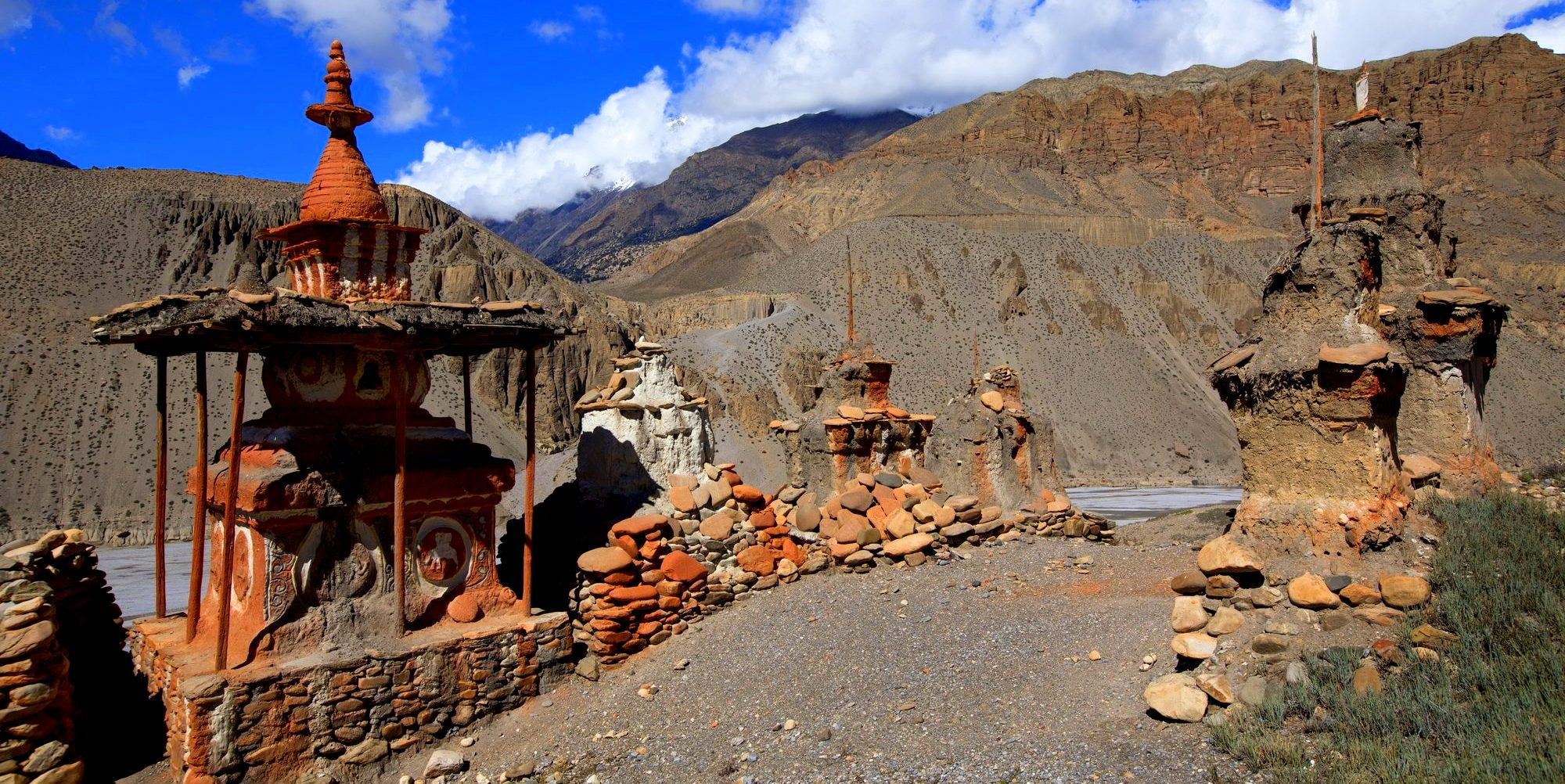
Route Overview: The trek typically starts and ends in Jomsom, which is accessible by flight or a long drive from Pokhara. The route traverses north to the walled capital of Lo Manthang, a city that seems frozen in time, where visitors can explore monasteries that are over a thousand years old and palaces that whisper tales of a bygone era. The trek follows a relatively moderate path along the banks of the Kali Gandaki River through arid landscapes dotted with settlements that showcase the stark yet beautiful architecture unique to this area.
Key Highlights
-
Lo Manthang: The walled capital city of the former Kingdom of Mustang, featuring ancient monasteries, royal palaces, and a vibrant cultural scene that includes the annual Tiji Festival.
-
Unique Landscapes: The trek offers views of wind-eroded hills and cliffs, unique geological formations, and a color palette that ranges from dull grays to vibrant reds and browns.
-
Cultural Richness: Upper Mustang is a treasure trove of ancient Tibetan Buddhism with monasteries that date back centuries, displaying exquisite murals and artifacts.
-
Restricted Area: Due to its sensitive location near the Tibetan border and its unique culture, the region remains a restricted area, with limited numbers of tourists allowed each year.
Difficulty: The trek is considered moderate, suitable for trekkers who can handle walking up to 5-6 hours a day on relatively flat or gently undulating paths. The highest altitude reached during the trek is only around 3,800 meters, which helps minimize the risk of altitude sickness.
Preparation and Tips
-
Permits: Trekking in Upper Mustang requires a special permit due to its status as a restricted area, with costs significantly higher than other treks in Nepal.
-
Guides and Porters: Given the restricted nature of the region and cultural sensitivities, hiring a local guide and possibly porters is not only recommended but often required.
-
Gear: Due to the arid and dusty conditions, good protection against the sun and wind is essential, along with standard trekking gear.
-
Cultural Sensitivity: Respecting local customs and traditions is crucial in this culturally preserved area, including dressing modestly and asking permission before taking photographs of people or religious sites.
The Upper Mustang Trek offers an adventure that is both geographical and historical, transporting trekkers to a part of the Himalayas that remains largely untouched by modern influences. It’s a journey back in time to a place where ancient Tibetan culture continues to thrive in Nepal’s remote mountainscapes. This trek is ideal for those looking to experience something truly different in the realm of high-altitude trekking.
Gokyo Lakes Trek
The Gokyo Lakes Trek is an exceptional alternative to the classic Everest Base Camp route, offering a unique blend of awe-inspiring scenery and less crowded trails. This trek is particularly famous for its series of beautiful turquoise lakes and the stunning panoramas from Gokyo Ri, including a magnificent view of Everest itself. It's a fantastic option for those looking to explore the Everest region's dramatic landscapes while also enjoying some of the quieter and more serene paths.
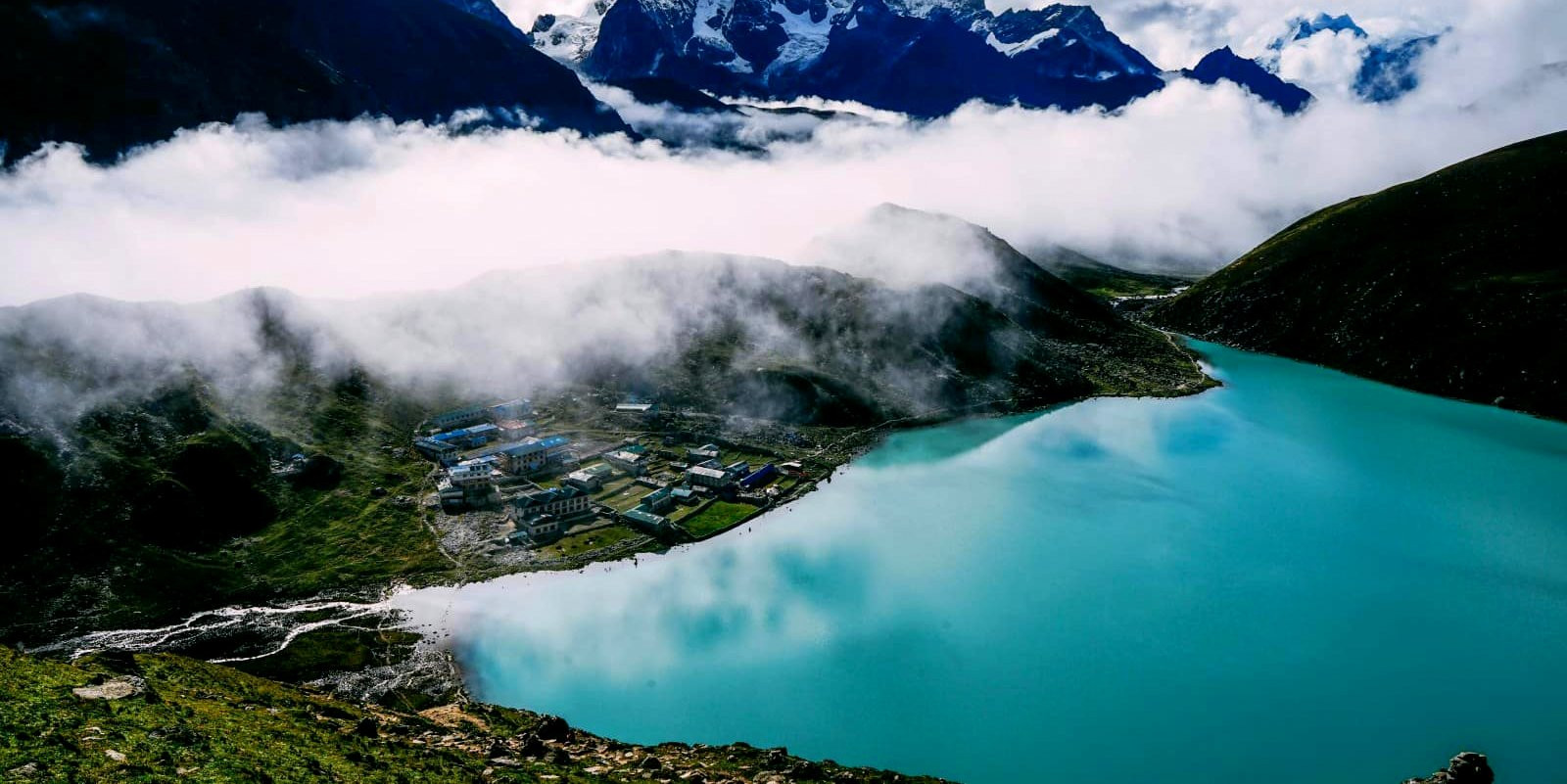
Route Overview: The trek usually starts with a flight from Kathmandu to Lukla, similar to the Everest Base Camp trek. From Lukla, trekkers head towards Namche Bazaar for acclimatization before diverging from the traditional EBC route to follow the trail towards the Gokyo Valley. The route includes crossing the Ngozumpa Glacier—Nepal's largest glacier—and ascending Gokyo Ri (5,357 meters), which offers one of the best panoramic views in the region, encompassing Everest, Lhotse, Makalu, and Cho Oyu.
Key Highlights
-
Gokyo Lakes: There are six main lakes in the Gokyo region, which are considered sacred by both Hindus and Buddhists. These lakes offer spectacular reflections of the snow-capped Himalayas.
-
Gokyo Ri: The summit of Gokyo Ri provides a less crowded but equally impressive alternative viewpoint to Kala Patthar on the traditional EBC trek.
-
Ngozumpa Glacier: Trekkers cross this glacier, which is the longest glacier in the Himalayas, offering dramatic views and a unique trekking experience.
-
Renjo La Pass: For those extending their trek, crossing Renjo La pass offers more adventurous trekking with stunning views and connects the Gokyo region with the remote Bhote Koshi valley.
Difficulty: The Gokyo Lakes Trek is considered moderate to challenging, primarily due to its high altitude and the steep ascent to Gokyo Ri. It typically takes about 12 to 15 days to complete, depending on the exact route and side trips.
Preparation and Tips
-
Acclimatization: Proper acclimatization days are crucial, particularly in Namche Bazaar and Gokyo, to adapt to the high altitude and reduce the risk of altitude sickness.
-
Gear: High-altitude trekking gear is necessary, including insulated jackets, good quality hiking boots, and layers to accommodate varying temperatures.
-
Permits: A TIMS card (Trekkers' Information Management System) and a Sagarmatha National Park permit are required for this trek.
-
Guides: Hiring a guide can enhance your experience by providing local knowledge and ensuring safety, especially when navigating glaciers and high passes.
The Gokyo Lakes Trek offers a remarkable adventure in the Everest region with fewer tourists compared to the base camp route. It combines natural beauty, from glistening glacial lakes to rugged mountain views, with the challenge of high-altitude trekking. This trek is perfect for those who seek to experience the majesty of the Himalayas in a more secluded and serene setting.
Kanchenjunga Base Camp
The Kanchenjunga Base Camp Trek is an extraordinary journey to the base of the world’s third highest peak, Mount Kanchenjunga, which rises to an impressive 8,586 meters. This trek is known for its remoteness and the pristine wilderness it offers, making it a perfect choice for adventurers seeking a challenging and less commercialized Himalayan experience.
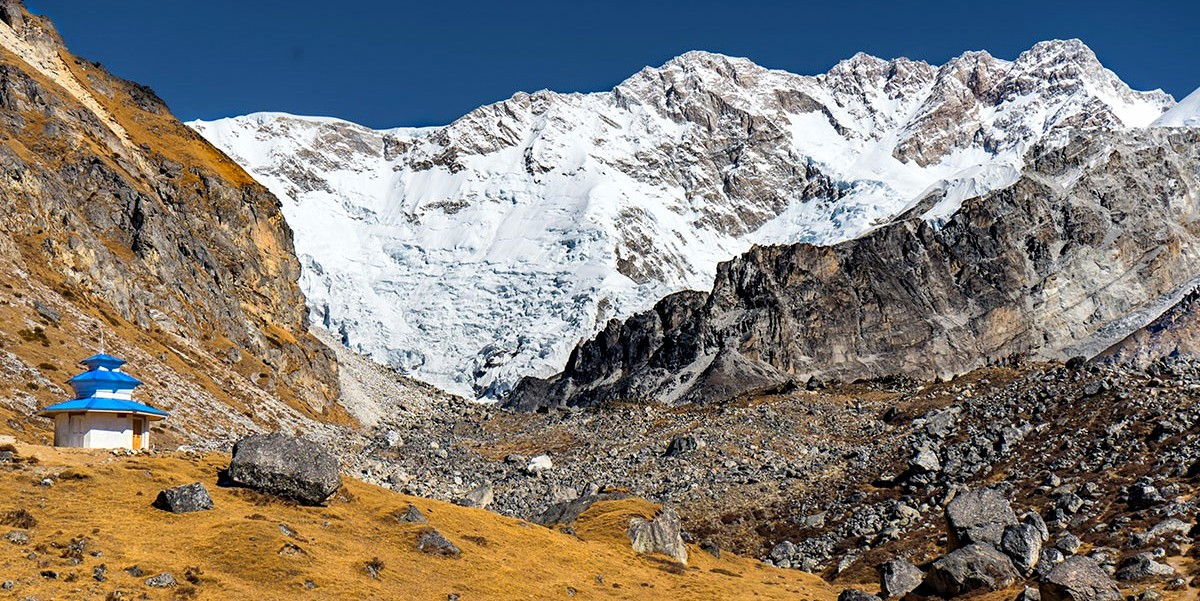
Route Overview: The trek can be approached from either the south or north base camp, but the most common route is from the south in Nepal. Starting from Suketar or Taplejung, which is accessed by a flight or a long drive from Kathmandu, the trail winds through the lush, terraced hillsides of eastern Nepal. It then ascends into the high alpine regions, passing through traditional Rai and Limbu villages, dense rhododendron forests, and eventually reaching the high, arid plateaus close to the Tibetan border. The trek typically includes visits to both the South and North Base Camps of Kanchenjunga, offering trekkers a complete experience of this majestic mountain.
Key Highlights
-
Diverse Ecosystems: The trek traverses through several climate zones, from subtropical jungles to alpine grasslands and high-altitude deserts.
-
High Mountain Passes: Includes crossing passes such as Sinion La, Mirgin La, and Lapsang La, offering dramatic views of the Himalayas.
-
Remote Villages: The path goes through isolated villages, where trekkers can experience the rich culture of Nepal’s ethnic communities like the Rais and Limbus.
-
Pristine Nature: The region is part of the Kanchenjunga Conservation Area, which is known for its biodiversity, including the possibility of spotting rare wildlife like the snow leopard and red panda.
Difficulty: The Kanchenjunga Base Camp Trek is considered very challenging due to its length, altitude, and remote location. Typically, the trek takes about 20-24 days to complete. The remote nature of this trek means that trekkers need to be well-prepared and self-sufficient, often carrying all necessary supplies for several days.
Preparation and Tips
-
Permits: Trekkers need a Kanchenjunga Conservation Area Permit and must also arrange a Restricted Area Permit, as Kanchenjunga is in a restricted area.
-
Guides and Porters: Due to the challenging nature of the trek and the regulations in the restricted areas, hiring a guide and possibly porters is mandatory.
-
Gear: Comprehensive high-altitude trekking gear is required, including layers for extreme cold, quality sleeping bags, and sturdy boots.
-
Physical Fitness and Experience: This trek requires excellent physical condition and prior trekking experience, especially at high altitudes.
The Kanchenjunga Base Camp Trek is not just a physical journey but an exploration into one of the world’s most untouched and stunningly beautiful natural landscapes. It offers an intense and rewarding trekking experience for those who wish to venture beyond the more frequented paths and dive deep into the raw heart of the Himalayas. This trek is a true adventure for the ardent trekker, providing isolation, challenge, and unparalleled scenic beauty.
Tips for Best Routes for Trekking in Nepal
Trekking in Nepal is an unforgettable adventure that offers incredible natural beauty, cultural immersion, and the challenge of navigating some of the highest peaks in the world. Whether you're planning to tackle the famous Everest Base Camp or explore the less trodden paths of the Kanchenjunga Base Camp, here are some essential tips to ensure you have the best experience on the trekking routes in Nepal:
Choose the Right Trek
-
Assess your fitness level: Different treks require varying levels of physical fitness. Assess your condition and choose a trek that suits your capabilities. Treks like the Ghorepani Poon Hill are suitable for beginners, while the Manaslu Circuit or Kanchenjunga Base Camp are better suited for experienced trekkers.
-
Consider your interests: Some treks, like the Upper Mustang, offer more cultural insights into ancient Tibetan lifestyles, while others, like the Gokyo Lakes Trek, are more focused on natural beauty.
Best Time to Trek
-
Avoid the monsoon: Plan your trek during the peak seasons of spring (March to May) and autumn (October to November). These periods offer the best weather conditions, with clear skies and moderate temperatures, ideal for trekking.
-
Consider off-season advantages: If you prefer solitude, trekking during the off-peak season (winter or summer) might be appealing, though you'll face challenges like colder temperatures and less stable weather.
Prepare Physically
-
Start training early: Engage in regular cardiovascular training such as walking, jogging, stair climbing, or hiking to build stamina and endurance.
-
Altitude training: If possible, train in high-altitude areas or use a stair climber to simulate uphill treks.
Pack Appropriately
-
Layered clothing: Weather can be highly variable, so pack layered clothing to accommodate everything from warm days to cold nights.
-
Essential gear: Include a sturdy pair of trekking boots, a sleeping bag suitable for freezing temperatures, a waterproof jacket, a first aid kit, and a headlamp.
Acclimatization and Altitude Sickness
-
Plan for acclimatization: Incorporate acclimatization days into your itinerary, especially for treks that go above 3,000 meters.
-
Know the symptoms of altitude sickness: Learn the signs of altitude sickness and understand the proper actions to take if symptoms occur.
Trekking Permits and Regulations
-
Obtain necessary permits: Ensure you have all required permits for your chosen trek. This can include the TIMS card, national park permits, and restricted area permits.
-
Follow local regulations: Respect local customs and practices, dress modestly, and follow the guidelines provided by your guides or local authorities.
Guide or Porter Services
- Consider hiring a guide or porter: Especially if you're trekking in remote areas or on challenging trails, having a local guide and a porter can enhance your trekking experience by ensuring safety and allowing you to focus on enjoying the trek.
Environmental and Cultural Respect
-
Leave no trace: Keep the trails clean, carry out all your trash, and avoid disturbing the wildlife.
-
Respect local cultures: Engage respectfully with local communities, participate in local traditions only if invited, and compensate fairly for services received.
Insurance
- Get travel insurance: Make sure your insurance covers high-altitude trekking and possible medical evacuation, which can be crucial in remote areas of the Himalayas.
By following these tips, you’ll be well-prepared to tackle the majestic trekking routes of Nepal safely and enjoyably, creating memories that will last a lifetime.
Ideal Time for Routes for Trekking in Nepal
Choosing the ideal time for trekking in Nepal largely depends on the specific region you plan to visit and the type of experience you are seeking. However, for most of the popular trekking routes, there are two optimal seasons when conditions are generally best:
Spring (March to May): Spring is one of the most popular times for trekking in Nepal due to the favorable weather conditions. Here are some reasons why spring is ideal:
-
Weather: The weather is generally stable, with clear skies and moderate temperatures, making it comfortable for trekking.
-
Visibility: This season offers excellent visibility, which is crucial for enjoying panoramic views of the Himalayas.
-
Flora: Spring is also the time when flowers bloom, notably rhododendrons, adding spectacular colors to the trekking trails, particularly visible in regions like the Annapurna Circuit.
Autumn (October to November): Autumn is another peak season for trekking in Nepal and is often considered the best time due to several factors:
-
Weather: Post-monsoon, the weather stabilizes, resulting in clear skies and reduced precipitation, which is ideal for high-altitude trekking.
-
Temperature: Temperatures are generally cool and pleasant, with less humidity, providing comfortable trekking conditions.
-
Festivals: Autumn also coincides with some of the major Nepalese festivals like Dashain and Tihar, offering trekkers a unique cultural experience.
Other Considerations
-
Winter (December to February): Winter is less popular due to the cold temperatures, especially at high altitudes where conditions can be quite harsh. However, treks in lower-altitude areas can still be enjoyable, with fewer crowds and clear skies.
-
Summer/Monsoon (June to September): Trekking during the monsoon is generally not advised due to heavy rains, slippery trails, and poor visibility. However, regions like Upper Mustang and Dolpo fall in the rain shadow of the Himalayas, making them viable options during this time as they receive significantly less rainfall.
Ultimately, the best time to trek depends on a variety of factors, including the specific trek, your personal preferences, and your readiness to face the various challenges each season presents. Most trekkers opt for the spring or autumn seasons to take advantage of the optimal weather conditions and the vibrant natural scenery or cultural vibrancy they offer.
From the culturally rich Annapurna Circuit, the remote Manaslu Circuit, and the scenic Everest Base Camp, Nepal's varied trekking routes suit explorers of all abilities. Nepal is ideal for a hiker since every route offers different cultural experiences and scenery. For perfect weather conditions and unobstructed sights, the best trekking times are spring (March to May) and autumn (October to November). Trekking in Nepal provides a memorable experience that marries great natural and cultural findings with physical challenge, whether you're seeking for excitement, seclusion, or cultural immersion.
FAQs for Best Routes for Trekking in Nepal
Q: What is the best time of year to go trekking in Nepal?
A: The optimal times for trekking in Nepal are during the spring (March to May) and autumn (September to November). These seasons offer stable weather, clear skies, and moderate temperatures, which are ideal for trekking.
Q: Do I need a guide to trek in Nepal?
A: While it's possible to trek independently in some regions, a guide can enhance your experience by providing local knowledge, language support, and assistance in case of emergencies. Some regions like Upper Mustang and Manaslu require a licensed guide due to their restricted status.
Q: What permits do I need for trekking in Nepal?
A: Most trekking routes require a TIMS (Trekkers' Information Management System) card and a regional conservation area or national park permit. Specific areas like Upper Mustang and Manaslu also require special restricted area permits.
Q: How physically demanding are the treks in Nepal?
A: The physical demand varies by trek. Shorter treks like the Poon Hill trek are suitable for beginners and families, while treks to Everest Base Camp or the Manaslu Circuit are more challenging and best suited for those with good physical fitness and trekking experience.
Q: How do I manage altitude sickness?
A: To minimize the risk of altitude sickness, ascend slowly to allow your body time to acclimatize, stay hydrated, eat a high-calorie diet, and avoid alcohol and smoking. Recognize the symptoms early, and descend if they worsen.
Q: What is the average cost of trekking in Nepal?
A: The cost depends on the route, duration, whether you hire guides and porters, and your style of accommodation and meals. Budget treks can cost as little as $20-$30 per day, while more extensive guided treks can cost $50-$150 per day.
Q: Can I trek solo in Nepal?
A: Yes, solo trekking is possible in many regions. However, for safety and better navigation, consider hiring a guide, especially in remote or restricted areas. Always register your trekking plans with a trusted contact or local authority.
Q: What are the accommodations like on trekking routes?
A: Accommodation ranges from basic teahouses offering Nepali and limited Western food and shared dormitory-style rooms to more comfortable lodges with private rooms in popular areas like the Everest and Annapurna regions.
Q: How do I respect local culture during my trek?
A: Learn a few basic phrases in Nepali, dress modestly, ask permission before taking photos, participate in local customs and traditions respectfully, and always follow local guidelines and regulations.
For the Nepal tour, please click here.
If you are looking for different kinds of Nepal Tours or Trekking Packages, feel free to contact us.
